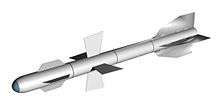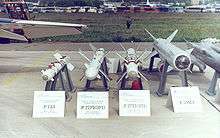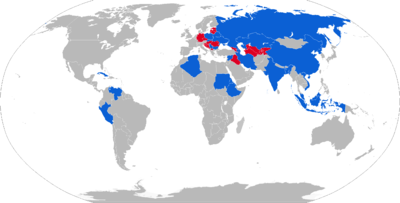R-27 (air-to-air missile)
| R-27 AA-10 Alamo | |
|---|---|
|
German Air Force MiG-29 firing an R-27 | |
| Type | Medium-range, air-to-air tactical missile, anti-radiation missile |
| Place of origin | Soviet Union |
| Service history | |
| In service | 1983- present |
| Wars |
Eritrean-Ethiopian War War in Donbass Yemeni Civil War (2015-present) Saudi-led intervention in Yemen (2015-present) |
| Production history | |
| Manufacturer | Vympel |
| Unit cost | N/A |
| Specifications | |
| Weight | 253 kg (558 lb) |
| Length | 4.08 m (13.4 ft) |
| Diameter | 230 mm (9.1 in) |
| Warhead | blast/fragmentation, or continuous rod |
| Warhead weight | 39 kg (86 lb) |
Detonation mechanism | radar-proximity and impact fuzes |
|
| |
| Engine |
High performance, w. directed-rocket motor Solid-fuel rocket motor |
| Wingspan | 772 mm (30.4 in) |
Operational range |
R-27R: up to 80 km R-27T: up to 70 km R-27ER: up to 130 km R-27ET: up to 120 km R-27EP: up to 130 km R-27EA: >130 km [1][2] |
| Flight altitude | N/A |
| Speed | Mach 4.5 |
Guidance system | semi-active radar homing (A/C), active-radar-homing (R-27EA), infrared homing (B/D), passive radar (E/F) |
Launch platform | Su-27, Su-30, Su-33, Su-34, Su-35, Su-37, MiG-23, MiG-29, Yak-141, Su-57, local conversion as a Surface to Air Missile in Yemen[3] |


The Vympel R-27 missile (NATO reporting name AA-10 Alamo) is a medium-to-long-range air-to-air missile developed by the Soviet Union. It remains in service with the Russian Air Force and air forces of the Commonwealth of Independent States.
The R-27 is manufactured in infrared-homing (R-27T)[4], semi-active-radar-homing (R-27R)[5], and active-radar-homing (R-27EA)[6] versions, in both Russia and Ukraine. The R-27 missile is carried by the Mikoyan MiG-29 and Sukhoi Su-27 fighters, and some of the later-model MiG-23MLD fighters have also been adapted to carry it. The R-27 missile is also license-produced in China, though the production license was bought from Ukraine instead of Russia.
Variants
- R-27R AA-10 Alamo-A, semi-active radar homing. Missile can be used at 20 to 25000 meters altitude (launch platform or target). Effective kill range for a target at same altitude: 2 to 42.5 km head-on, 0.7 to 7.5 km tail-on. Maximum range: 73 km. Maximum allowed vertical separation between target and launch platform: +/- 10 km.[7]
- R-27T AA-10 Alamo-B, infrared homing, passive homing using the Avtomatika 9B-1032 (PRGS-27) IR seeker head. Missile can be used at 20 to 25000 meters altitude. Effective kill range for a target at same altitude: 2 to 33 km head-on, 0 to 5.5 km tail-on. Maximum range: 63 km. Maximum allowed vertical separation: +/-10 km.[7]
- R-27ER AA-10 Alamo-C, the semi-active-radar homing extended-range version. Missile can be used at 20 to 27000 meters altitude. Effective kill range for a target at same altitude: 2 to 65.5 km head-on, 0.7 to 16.5 km tail-on. Missile cannot be fired at altitude less than 3 km against a target with background earth, if launch range is less than 6 kilometers. Maximum range: 117 km. Maximum allowed vertical separation: 12 km.[7]
- R-27ET AA-10 Alamo-D, the infrared-homing extended-range version, Weight 348 kg. Missile can be used at 20 to 27000 meters altitude. Effective kill range: 2 to 52.5 km head-on, 0.7 to 12.5 tail-on. Maximum range: 104 km. Maximum allowed vertical separation: 12 km.[7]
R-27R and ER variants can be used in any meteorological conditions. Launch can made at less than 5 g overload and less 50 deg/s roll rate.[7] It is allowed to redesignate targets during flight, or sharing target illumination with other aircraft.
R-27T and ET variants can be used out of cloudiness, at least 15 degrees away from the bearing of sun, and 4 degrees away from the bearing of moon and ground-based head-contrasting conditions. In cases of maximum head-on range launches where lock-command cannot be utilised, missile can be fired in PPS: In this mode, missile will fly straight until achieves target lock. As missile lacks capability of maneuvering before lock, aircraft itself must maneuver so that missile will be pointed to no more than 15 degrees bearing of the target for confident capture by the IR seeker after launch. Equalising altitude is recommended but not required.[8] On combat operations section of the Su-27 manual, this mode of usage is especially recommended for head-on usage for passive attacks at targets with 0 degrees approach angle (i.e. another fighter moving to intercept), leaving target unalerted to incoming missile.[9] Launch can be made at 0 to 7 g, but limited to 6 g if roll induced slip is more than 2x diameter of the ball.[7]
Other Variants:
Operational service
Ethiopia and Eritrea
In the 1999 Eritrean-Ethiopian War, Eritrean MiG-29s fought Ethiopian Su-27s both piloted by Russian mercenaries.[10] There were possibly as many as 24 R-27s fired by both sides. Only one R-27 fired by an Ethiopian Su-27 at an Eritrean MiG-29 proximity-fuzed near enough the MiG that the damaged aircraft eventually crashed on landing, giving the R-27 a hit ratio of only 4%.[11][12]
Ukraine
During the War in Donbass, the Ukrainian Air Force claimed that one of its Su-25 was shot down by a Russian Air Force MiG-29 using a R-27T on 16 July 2014.[13] Russian officials denied any involvement.[14]
Yemen
During the Yemeni Civil War (2015-present) Houthis have used R-27T missiles modified to serve as surface to air missiles. A video released on January 7, 2018 also shows a modified R-27T hitting a Saudi F-15 on a Forward looking infrared camera. Houthi sources claim to have downed the F-15, although this has been disputed, as it appears the missile proximity detonated, though the F-15 continued to fly in its trajectory seemingly unaffected.[15][16]Rebels later released footage showing an aircraft wreck, however serial numbers on the wreckage suggested the aircraft was a Panavia Tornado, also operated by Saudi forces. On January 8, the Saudi Press Agency admitted the loss of an aircraft over Yemen, though it did not clarify whether it was a Tornado or an F-15.[17]
On 21 March 2018, Houthi rebels released a video where they hit and possibly shot down a Saudi F-15 in Saada province.[18][19] In the video a R-27T air to air missile adapted for surface to air use was launched, appearing to have successfully hit a jet. As in the video of the previous similar hit recorded on 8 January, the target, while clearly hit, did not appear to be downed. Saudi forces confirmed the hit, while saying the jet safely landed at a Saudi base.[20][21] Saudi official sources confirmed the incident reporting that it happened at 3:48 pm local time after a surface-to-air defense missile was launched at the fighter jet from inside Saada airport.[22][3]
Operators

Current operators
Former operators











.svg.png)
.svg.png)
See also
Similar weapons
References
- Citations
- 1 2 "The Russian Philosophy of Beyond Visual Range Air Combat". ausairpower.net. 2012. Archived from the original on 30 January 2012. Retrieved 24 November 2012.
- 1 2 Dr C Kopp. "The Russian Philosophy of Beyond Visual Range Air Combat". Archived from the original on 30 January 2012.
- 1 2 "Saudi Arabia says F-15 survived SAM hit over Yemen - Jane's 360". www.janes.com. Archived from the original on 25 March 2018.
- ↑ "Tactical Missiles Corporation JSC". eng.ktrv.ru. Archived from the original on 3 March 2014.
- ↑ "Tactical Missiles Corporation JSC". eng.ktrv.ru. Archived from the original on 15 September 2013.
- ↑ "Tactical Missiles Corporation JSC". eng.ktrv.ru. Archived from the original on 9 January 2015.
- 1 2 3 4 5 6 Su-27 Flight Manual booklet-1. 2001. p. 129.
- ↑ Su-27 Flight Manual booklet-1. 2001. p. 151.
- ↑ Su-27 Flight Manual booklet-1. 2001. p. 150.
- ↑ Smith, Charles. "Russian Mercenaries Flying For Ethiopia." Archived 27 September 2010 at the Wayback Machine. WorldNetDaily, 18 July 2000. Retrieved: 24 October 2010.
- ↑ Adal voice of Eritrean's / By:The Air Combat Information Group "Quarrels Over the Border." Archived 11 August 2011 at the Wayback Machine., April 18, 2008. Retrieved: 26 October 2010.
- ↑ Cooper, Tom and Jonathan Kyzer. "Ethiopian Eritrean War, 1998 - 2000." Archived 10 February 2009 at the Wayback Machine. ACIG.org, 10 February 2008. Retrieved: 24 October 2010.
- ↑ "Russian military plane shot down Ukrainian Su-25 aircraft in Ukraine". Archived from the original on 15 November 2015.
- ↑ "Russia Rejects 'Absurd' Accusation Over Downed Ukrainian Jet". RadioFreeEurope/RadioLiberty. Archived from the original on 17 July 2014.
- ↑ "Archived copy". Archived from the original on 9 January 2018. Retrieved 9 January 2018.
- ↑ "Yemen rebels release F-15 'shoot down' footage - Jane's 360". www.janes.com. Archived from the original on 24 March 2018.
- ↑ "Archived copy". Archived from the original on 24 March 2018. Retrieved 24 March 2018.
- ↑ Sputnik. "Yemen's Houthi Rebels Claim They Hit Saudi Arabian F-15 Jet - Reports (VIDEO)". sputniknews.com. Archived from the original on 22 March 2018.
- ↑ "Saudi Military F - 15 fighter jet shot down in Yemen: Report". timesofislamabad.com. 22 March 2018. Archived from the original on 13 May 2018.
- ↑ "محمد بن خالد on Twitter". twitter.com. Archived from the original on 13 May 2018.
- ↑ "Saudi Arabia says F-15 survived SAM hit over Yemen - Jane's 360". www.janes.com. Archived from the original on 24 March 2018.
- ↑ "Coalition fighter jet unsuccessfully targeted by defense missile over Saada". english.alarabiya.net. Archived from the original on 25 March 2018.
- Bibliography
- Gordon, Yefim (2004). Soviet/Russian Aircraft Weapons Since World War Two. Hinckley, England: Midland Publishing. ISBN 1-85780-188-1.
External links
| Wikimedia Commons has media related to Vympel_R-27. |